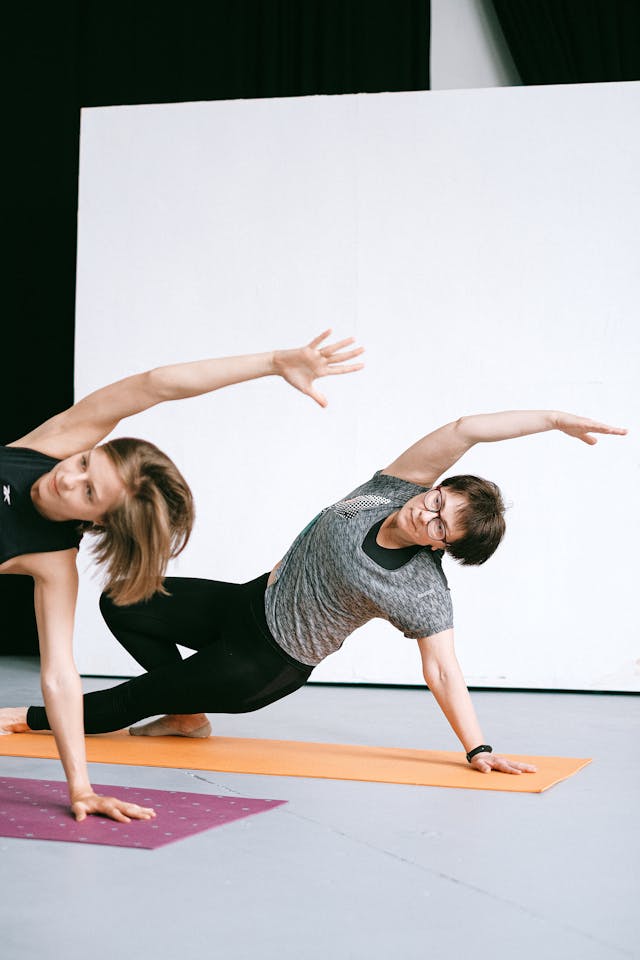Table of Contents
Introduction
Yoga has been a cornerstone of fitness and wellness for centuries. Its benefits for the mind and body are well-documented, providing a perfect blend of physical exercise and mental relaxation. But what if you could add an extra layer of intensity to your yoga practice? Enter high-intensity yoga, a dynamic fusion of traditional yoga poses with high-energy movements designed to push your limits and boost your fitness levels.
What is High-Intensity Yoga?
High-intensity yoga combines the mindful movements of yoga with the cardiovascular and muscle-building benefits of high-intensity interval training (HIIT). Unlike traditional yoga, which often focuses on slow, deliberate movements and breathing, high-intensity yoga ramps up the pace and introduces elements that increase your heart rate and challenge your muscles in new ways.
Benefits of High-Intensity Yoga
Physical Benefits
High-intensity yoga can help you build strength, increase flexibility, and improve cardiovascular health. By integrating fast-paced sequences and powerful poses, it offers a full-body workout that can help you burn calories and tone muscles.
Mental Health Benefits
Beyond the physical, high-intensity yoga can also enhance your mental well-being. The combination of physical exertion and mindful breathing helps reduce stress, improve focus, and boost overall mood.
Who Can Practice High-Intensity Yoga?
High-intensity yoga can be practiced by various individuals, but it’s important to consider certain factors before starting. This type of yoga is often suitable for people who:
- Have a Good Fitness Level: Those with a solid foundation in physical fitness will find it easier to keep up with the demands of high-intensity yoga.
- Experienced Yogis: Individuals who have been practicing yoga for a while and are familiar with different poses and breathing techniques are better prepared for the challenges.
- Athletes: Athletes or those who engage in regular, intense physical activity can benefit from high-intensity yoga as it complements their existing training routines.
- Healthy Individuals: Those without any major health concerns, injuries, or chronic conditions are generally good candidates for this vigorous form of yoga.
- People Looking for a Challenge: Individuals who enjoy pushing their limits and seeking a more rigorous workout will likely appreciate the intensity.
However, it’s crucial for anyone interested in high-intensity yoga to listen to their body, start slowly, and possibly consult with a healthcare professional or an experienced yoga instructor to ensure it is appropriate for their fitness level and health status.
Preparing for High-Intensity Yoga
Preparing for high-intensity yoga requires attention to several key aspects to make the experience effective and safe:
- Build a Strong Foundation: Before diving into high-intensity yoga, it’s important to have a good understanding of basic yoga poses and techniques. This foundation will help you transition smoothly into more demanding practices.
- Warm-Up: Always start with a proper warm-up to get your muscles ready and reduce the risk of injury. Gentle stretches and light exercises can help prepare your body.
- Stay Hydrated: Drink plenty of water before, during, and after your session. High-intensity yoga can be quite demanding, and staying hydrated helps maintain performance and recovery.
- Wear Appropriate Gear: Choose comfortable, breathable clothing that allows for a full range of motion. A good yoga mat with adequate grip can also prevent slipping and provide support.
- Listen to Your Body: Pay attention to how your body feels during the practice. If you experience pain or extreme discomfort, take a break or modify the pose to suit your comfort level.
- Breathe Properly: Focus on your breathing techniques. Proper breathing can help you maintain endurance and manage the intensity of the practice.
- Gradual Progression: Start with shorter sessions and gradually increase the duration and intensity as your strength and stamina improve. This approach helps your body adapt without overwhelming it.
- Rest and Recover: Allow time for rest and recovery between high-intensity sessions. This period is crucial for muscle repair and overall well-being.
- Consult a Professional: If you’re new to high-intensity yoga or have any health concerns, consider seeking guidance from a certified yoga instructor or healthcare professional.
By preparing adequately, you can enjoy the benefits of high-intensity yoga while minimizing the risk of injury and maximizing the effectiveness of your practice.
Related Article:
- Enhancing Spinal Health Through Yoga: This link can be added to the “Physical Benefits” section to highlight how yoga can improve spinal health.
- Improved Flexibility and Mobility with Yoga: This link can be used in the “Physical Benefits” section to discuss the flexibility benefits of high-intensity yoga.
Basic High-Intensity Yoga Poses
Basic high-intensity yoga poses are designed to build strength, flexibility, and endurance. Here are some key poses to get you started:
- Sun Salutations (Surya Namaskar): This series of poses is often used as a warm-up in high-intensity yoga. It includes a sequence of movements like forward bends, lunges, and upward-facing dogs, flowing smoothly from one to the next.
- Warrior I (Virabhadrasana I): This pose strengthens the legs, opens the hips and chest, and stretches the arms and legs. It also improves focus and stability.
- Warrior II (Virabhadrasana II): Building on Warrior I, this pose further engages the legs and core, enhances balance, and stretches the hips and groin.
- Chair Pose (Utkatasana): This pose works the legs and glutes intensely while also engaging the core and arms. It’s like sitting back in an imaginary chair.
- Plank Pose: A fundamental pose for building core strength. It also engages the shoulders, arms, and legs, serving as a great preparation for more complex poses.
- Chaturanga Dandasana (Four-Limbed Staff Pose): This low plank position builds arm, shoulder, and core strength. It’s a challenging transition often used in vinyasa flows.
- Boat Pose (Navasana): This core-centric pose strengthens the abdominal muscles, hip flexors, and spine. It also improves balance and concentration.
- Crow Pose (Bakasana): This arm balance pose strengthens the arms, wrists, and core while improving balance and concentration. It requires engaging the whole body to maintain stability.
- High Lunge (Crescent Lunge): This dynamic pose strengthens the legs and glutes, stretches the hips, and improves balance. It also engages the core and upper body.
- Side Plank (Vasisthasana): A variation of the plank that targets the obliques, shoulders, and arms. It enhances core stability and balance.
Incorporating these basic poses into your high-intensity yoga routine can help you build strength, flexibility, and endurance, providing a solid foundation for more advanced practices.
Related Article:
- Yoga Poses to Lose Weight: This link can be included in the “High-Intensity Yoga for Weight Loss” section to emphasize the weight loss benefits of high-intensity yoga.
Advanced High-Intensity Yoga Poses
Advanced high-intensity yoga poses demand strength, flexibility, and balance. Here are some challenging poses to incorporate into your practice:
- Handstand (Adho Mukha Vrksasana): This inversion requires strong arms, shoulders, and core. It also improves balance and concentration.
- Forearm Stand (Pincha Mayurasana): A variation of the handstand, this pose demands stability and strength in the shoulders, arms, and core.
- Scorpion Pose (Vrschikasana): An advanced backbend and inversion, this pose requires flexibility in the spine, strength in the arms and shoulders, and a strong core.
- Firefly Pose (Tittibhasana): This arm balance strengthens the wrists, arms, and core while stretching the hamstrings and opening the hips.
- Eight-Angle Pose (Astavakrasana): This complex arm balance engages the core, arms, and legs, requiring strength, flexibility, and coordination.
- Peacock Pose (Mayurasana): Balancing on the hands with the body parallel to the floor, this pose strengthens the wrists, arms, and core, and demands good balance.
- Wheel Pose (Urdhva Dhanurasana): An intense backbend that opens the chest, shoulders, and hip flexors while strengthening the arms, legs, and back.
- King Pigeon Pose (Eka Pada Rajakapotasana): This deep backbend and hip opener requires flexibility in the spine, shoulders, and hips, along with balance and strength.
- Crow Pose to Headstand (Bakasana to Sirsasana): Transitioning from an arm balance to an inversion, this sequence requires strength, control, and concentration.
- Flying Pigeon Pose (Eka Pada Galavasana): Combining a hip opener with an arm balance, this pose strengthens the arms and core while enhancing flexibility in the hips.
Incorporating these advanced poses into your high-intensity yoga routine can push your physical and mental limits, offering a challenging and rewarding practice.

Combining High-Intensity Intervals with Yoga
Combining high-intensity intervals with yoga can create a dynamic and effective workout. Here’s how you can do it:
- Warm-Up with Yoga: Begin your session with a series of gentle yoga poses to prepare your muscles and joints. Sun Salutations are a great way to start.
- High-Intensity Intervals: Incorporate short bursts of high-intensity exercises such as burpees, jump squats, or mountain climbers. These exercises should last for 30 seconds to a minute.
- Yoga Recovery: Follow each high-intensity interval with a yoga pose that helps with recovery and stretches the muscles worked. For example, after a set of burpees, move into Downward Dog or Child’s Pose.
- Strength Poses: Integrate yoga poses that build strength, such as Warrior II or Plank Pose, in between intervals. Hold these poses for a minute to build endurance.
- Balance Exercises: Add balancing poses like Tree Pose or Eagle Pose to improve stability and core strength. These can be done after high-intensity intervals to allow your heart rate to come down slightly.
- Cool Down with Yoga: End your session with calming yoga poses to stretch out the muscles and lower your heart rate. Seated Forward Bend and Supine Twist are good choices.
- Breathing Techniques: Incorporate deep breathing exercises throughout your workout to maintain focus and control your heart rate.
- Interval Timing: Structure your workout with a timer. For example, alternate between 1 minute of high-intensity exercise and 1 minute of yoga recovery.
Safety Tips for High-Intensity Yoga
Listening to Your Body
Pay attention to how your body feels during your practice. If you experience pain or discomfort, modify the pose or take a break.
Modifying Poses
Don’t be afraid to use props or modify poses to suit your fitness level. It’s better to perform a modified pose correctly than to risk injury by pushing too hard.
High-Intensity Yoga for Weight Loss
Calorie Burn
The combination of strength training and cardio in high-intensity yoga can help you burn more calories compared to traditional yoga. This makes it an effective workout for weight loss.
Boosting Metabolism
High-intensity yoga can boost your metabolism, helping you burn more calories even after your workout is over.
High-Intensity Yoga for Building Strength
Muscle Engagement
Many high-intensity yoga poses require significant muscle engagement. This helps build strength in your core, arms, legs, and back.
Core Strength
Poses like crow and handstands are excellent for building core strength, which is essential for overall stability and balance.
Mental Health Benefits of High-Intensity Yoga
Stress Relief
Physical exertion combined with mindful breathing helps reduce stress and anxiety. It’s a great way to clear your mind and focus on the present moment.
Improved Focus
High-intensity yoga requires concentration and focus, which can translate to improved mental clarity and productivity in other areas of your life.
FAQs
Is HIIT Yoga Effective?
Yes, HIIT (High-Intensity Interval Training) yoga is effective. It combines the benefits of traditional yoga with the intensity of HIIT, providing a comprehensive workout. This combination improves cardiovascular fitness, builds strength, enhances flexibility, and aids in weight management. The alternating high-intensity exercises and yoga poses create a balanced routine that can cater to various fitness goals.
Can Yoga Be Intense?
Absolutely, yoga can be intense. While many associate yoga with gentle stretching and relaxation, there are styles and poses that are quite challenging. Practices like Ashtanga, Vinyasa, and Power Yoga involve dynamic movements and strength-building poses that can elevate heart rate and build endurance. Advanced poses and sequences can test flexibility, balance, and strength, making yoga a rigorous workout.
What Is Hot HIIT Yoga?
Hot HIIT yoga is a fusion of high-intensity interval training and yoga practiced in a heated room, typically around 95-100 degrees Fahrenheit (35-38 degrees Celsius). The heat adds an extra layer of intensity, increasing heart rate and promoting sweating, which can help with detoxification. The combination of heat and high-intensity intervals challenges the body further, enhancing the workout’s effectiveness in improving fitness and flexibility.
Can You Lose Weight with HIIT Yoga?
Yes, you can lose weight with HIIT yoga. The high-intensity intervals boost metabolism and burn calories quickly, while the yoga component helps build muscle and improve flexibility. The combination of these elements makes HIIT yoga an efficient way to create a calorie deficit necessary for weight loss. Additionally, the variety in the workout helps keep it engaging, which can lead to better adherence and long-term success in weight management.
Conclusion
High-intensity yoga is an exciting and challenging way to enhance your fitness routine. By combining the mindful movements of yoga with the intensity of interval training, you can enjoy a full-body workout that benefits both your body and mind. Give high-intensity yoga a try and discover a new way to stay fit and healthy.







